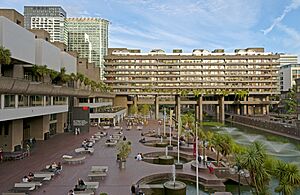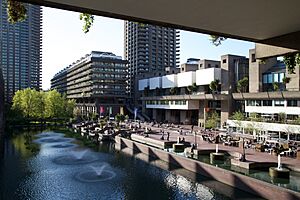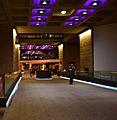Barbican Centre facts for kids

Barbican Lakeside on a summer evening
|
|
| Address | Silk Street London, EC2 United Kingdom |
|---|---|
| Coordinates | 51°31′13″N 0°05′42″W / 51.5202°N 0.0950°W |
| Public transit | |
| Owner | City of London Corporation |
| Designation | Grade II |
| Type | performing arts centre |
| Capacity | Barbican Hall: 1,943 Barbican Theatre: 1,156 The Pit: 200 Barbican Film Cinema 1: 288 Cinema 2: 156 Cinema 3: 156 |
| Construction | |
| Opened | 1982 |
| Architect | Chamberlin, Powell and Bon |
The Barbican Centre is a huge place in London, England, where you can enjoy many different kinds of arts. It's one of the biggest performing arts centers in Europe! At the Barbican, you can watch classical music concerts, modern music shows, theatre plays, and movies. It also has art shows, a library, restaurants, and even a special garden called a conservatory.
Two famous orchestras, the London Symphony Orchestra and the BBC Symphony Orchestra, perform regularly at the Barbican. The Royal Shakespeare Company, a well-known theatre group, also performs here. They returned to the Barbican in 2013.
The Barbican Centre is owned and managed by the City of London Corporation. It was built as a special gift to the country and cost a lot of money. Queen Elizabeth II officially opened it on March 3, 1982. The building has a unique style called brutalist architecture, which uses a lot of concrete.
Contents
What You Can See and Do at the Barbican
The Barbican Centre has many different spaces for performances and activities. Here are some of the main ones:
- Barbican Hall: This is a large concert hall that can hold 1,943 people. It's the main home for the London Symphony Orchestra and the BBC Symphony Orchestra.
- Barbican Theatre: This theatre has 1,156 seats and was designed especially for the Royal Shakespeare Company.
- The Pit: This is a smaller, flexible theatre space that can seat about 200 people.
- Barbican Art Gallery: Here you can see different art exhibitions. There's also 'The Curve', a gallery that shows new art.
- Barbican Film: The centre has three cinema screens where you can watch movies. They can seat 288, 156, and 156 people.
- Barbican Library: This is a public library with special collections of books about arts and music. It also has a children's library with free events.
- Restaurants: There are three restaurants where you can grab a bite to eat.
- Conference and Exhibition Halls: The Barbican also has spaces for meetings and large shows.
The Barbican Library is one of the biggest public libraries in London. It has a special collection of historical books about London, some from the 1700s! You can even borrow these books. The music library has two pianos that anyone can use for free.
History and Design of the Barbican
The Barbican Centre took a long time to build. It opened several years after the homes around it, called the Barbican Estate, were finished. The area where it stands was heavily bombed during World War II.
The Barbican Centre was designed by architects Chamberlin, Powell and Bon. Its style is called Brutalist because it uses a lot of concrete and has a strong, blocky look. The building has a complicated layout with many entrances and different levels. To help visitors, lines are painted on the ground outside to guide them to the centre.
The design of the Barbican has always been a topic of discussion. Some people love its unique look, while others don't. In 2003, it was even voted "London's ugliest building" in one poll.
In 2001, the Barbican Centre was given a special status as a Grade II listed building. This means it's an important building that needs to be protected because of its special design and size. The same architects who designed the Barbican Centre also designed the homes around it.
Over the years, the Barbican Centre has had updates to make it better. In 2005-2006, it was refurbished to make it easier for people to move around inside. They also added clear signs and an internal bridge. The entrance on Silk Street was also improved to make it more welcoming for people walking in.
Outside, a main feature of the centre is a beautiful lake with a terrace. The theatre's tall section, called a fly tower, was covered in glass and turned into a high-level conservatory, which is like a large greenhouse.
The sound quality in the Barbican Hall has also been discussed. Some people thought it sounded warm, while others felt it was too "dry" for big orchestras. Improvements were made to the hall's acoustics in the 1990s and early 2000s to make the sound better.
The Barbican Theatre was built to be the London home for the Royal Shakespeare Company (RSC). The RSC helped design the theatre. However, in 2002, they decided not to continue their contract there. They felt they needed more performance space. But in 2013, the RSC announced they would return to the Barbican Centre for a three-year season of Shakespeare's history plays.
In 2017, there was a plan to build a new concert hall called the Centre for Music, London near the Barbican. However, these plans were cancelled in 2021.
The Guildhall School of Music and Drama and the City of London's Barbican Library are also located nearby. The Museum of London is also close by, within the Barbican Estate.
London Australian Film Festival
The annual London Australian Film Festival (LAFF) used to be held at the Barbican Theatre from 1994 until 2011. A new festival with the same name started in 2017, but it is not connected to the one that was at the Barbican.
Images for kids
Nearby Transport Links
You can get to the Barbican Centre using several train and underground stations:
- Barbican tube station
- Farringdon station
- Liverpool Street railway station
- Moorgate tube station
- St Paul's tube station
See also
 In Spanish: Barbican Centre para niños
In Spanish: Barbican Centre para niños
- York Barbican
- Culture of London
- List of concert halls











